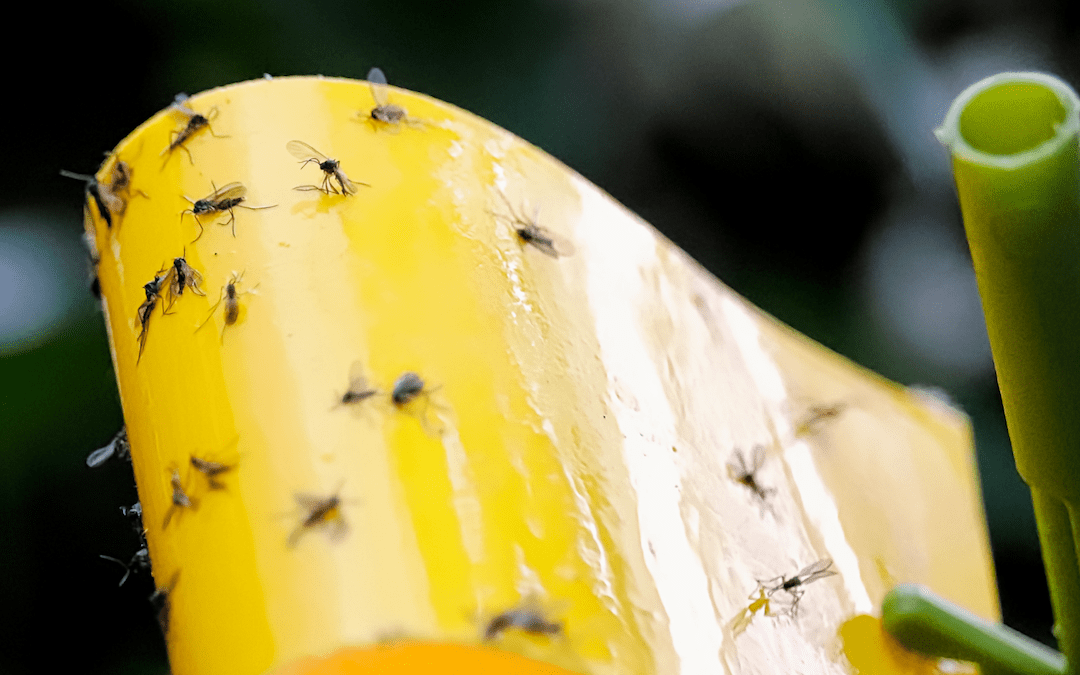Aren’t gnats just one of the most annoying pests out there? It seems like they appear out of nowhere sometimes. Anyone who has had houseplants in their homes for awhile have probably encountered gnats. I’ve known plant lovers who have chucked an entire plant, pot and all, into the trash bin because these pests have become so frustrating. Been there? Maybe this blog will offer a little hope. We’re talking fungus gnats today.
Fungus gnats are garden pests that are generally no larger than about a 16th of an inch! Although they are winged creatures, they pretty much stink at flying, which is why you often see them hovering around an infested plant, and why they kind of scatter and then settle back in when the soil or foliage of your plant is disturbed. While fungus gnats are incredibly annoying, they can be controlled, and even more importantly, prevented.
Fungus gnats are attracted to overly moist soil. Overwatering houseplants is the top reason that fungus gnat populations develop. The gnats are attracted to the moist environment, they lay their eggs (100- 300 of them!), the larvae feeds on the organic material in the soil and any fungus that develops, and then the whole cycle repeats. See how this can quickly become a nightmare? Proper watering will go a long way to prevent many problems in addition to preventing an infestation of fungus gnats.
- It is imperative to ease up on your watering of houseplants if you find any presence of fungus gnats. (This is especially important throughout winter when it takes extra long for soils to dry out.) It is also important to make sure any plants you are bringing in for the winter do not already have this issue as well.
- Make sure your plant pots and containers have good drainage. This means buy pots with holes in the bottom of them or drill your own holes if you have to.
- Allow soil in pots to dry out between watering. Don’t go by sight; stick your finger into the pot and feel your soil to make sure you really need to water.


Now you know about preventing fungus gnats and that’s all good and well, but what do you do if you already have the problem?
There a couple of remedies that we have found to work really well for the control of fungus gnats. You can start by replacing the top 1/2 inch to inch of soil in your pots. If you have a smaller potted plant and you’ve repeatedly experienced more gnats than you want to see in your lifetime, you might even want to start completely fresh and repot the plant in new soil. (Don’t opt for the moisture control potting mixes for indoor plants. It tends to keep the soils too moist for houseplants.)
- As far as products go, Mosquito Bits (soaked in water and used as a soil drench), Bacillus thuringiensis (as a spray or soil drench to kill the larvae), beneficial nematodes to treat the soil/kill larvae, and Neem Oil as a soil drench and a foliar spray (make sure not to spray in direct sunlight or when temps are high). Always read the labels of your products and keep in mind that there may be subsequent applications needed.
- Yellow sticky cards are helpful for monitoring the presence of adult pests. Fungal gnats get stuck to the card so you’ll be able to see them clearly and take action. The adult gnats get stuck and can’t lay eggs, so you break up part of the vicious cycle.
*Extra advice: While we generally think of gnats more of a nuisance more than a destructive pest, it is important to note that gnat larvae can still cause some damage and they may eat tiny roots and root hairs on seedlings (when there is no fungus to munch on) and can even burrow into their tender stems at the base of the soil. They have also been known to spread disease to other plants.


Trackbacks/Pingbacks